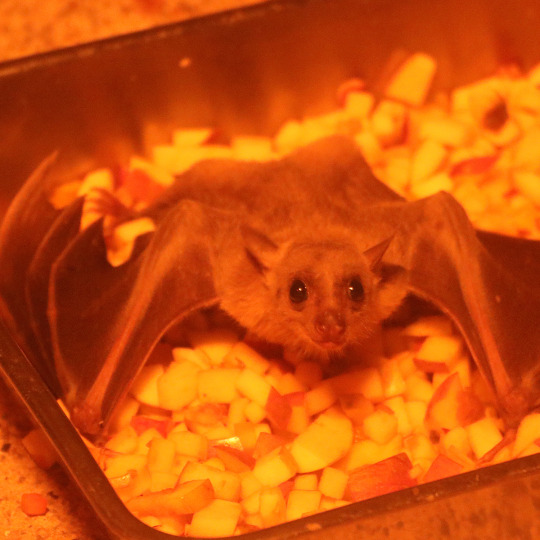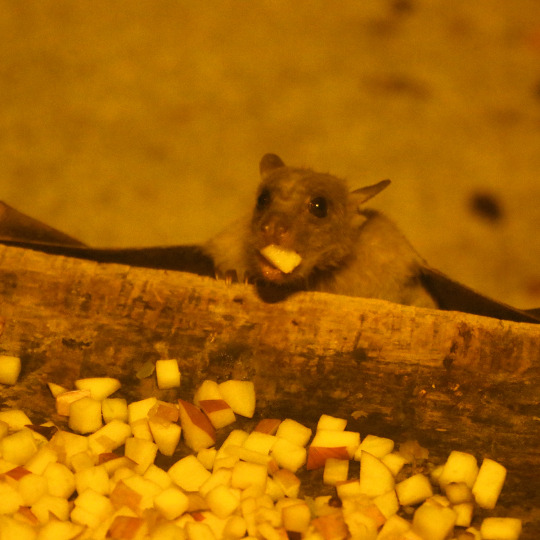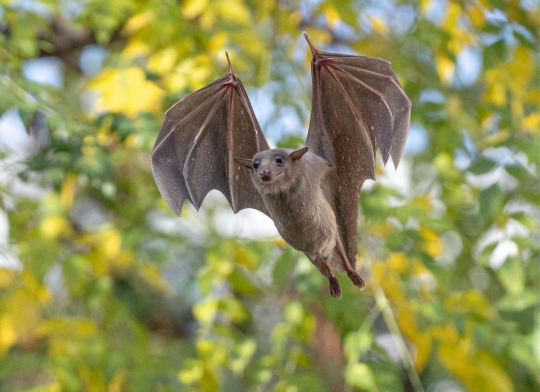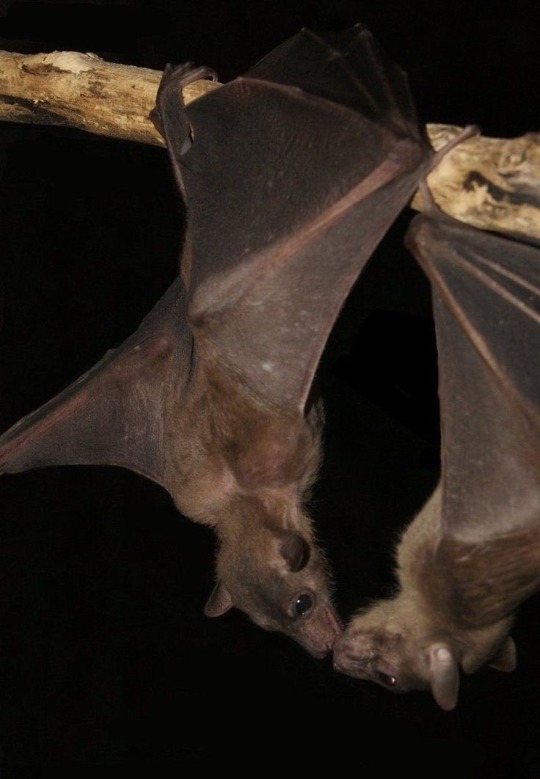#rousettus
Explore tagged Tumblr posts
Text


all-you-can-eat
@東山動植物園
@Higashiyama Zoo & Botanical Gardens
#東山動植物園#Egyptian fruit bat#Egyptian rousette#Rousettus aegyptiacus#オオコウモリ#エジプトルーセットオオコウモリ#ルーセットオオコウモリ#fruit bat#bat#mammal
1K notes
·
View notes
Text

You can fit so many deadly zoonotic filoviruses in this little guy
4 notes
·
View notes
Note
the Egyptian fruit bat persnaps? :3
Absolutely!


#african wildlife#middle eastern wildlife#bat#bats#fruit bat#egyptian fruit bat#mammalia#chiroptera#mega bat#animal polls#poll blog#my polls#animals#polls#tumblr polls
242 notes
·
View notes
Text

Egyptian fruit bat | Rousettus aegyptiacus
Also known as the Egyptian rousette, this bat primarily resides in Africa, though can be found in some surrounding countries. They eat a selection of fruits and are quite important for both seed dispersal and pollination!
Have you ever heard of the phrase "blind as a bat"? The truth is, a lot of bats are just about as blind as we humans are. Fruit bats tend to see in the dark better than their insectivorous relatives, which is helpful to identify which fruits are good to eat and which aren't! Sense of smell takes a big role in this as well.
🦇
#boras posts#mammal#bats#bat week#wildlife#animals#i keep forgetting to schedule ahead of time >_<#keep ending up typing them last minute
34 notes
·
View notes
Text

Your Daily Batty Dose!
Egyptian fruit bats (Rousettus aegyptiacus)
{x}
351 notes
·
View notes
Note
hallo
I was wondering if you cold maybe do a Rousettus bat stimboard (preferably with clicky sounds but I’m not too set on anything, and it doesn’t have to be specifically rousettus either, just preferably megabats/fruit bats). That’d be very amazing ty :D










Megabats/fruit bats stimboard, with clicky stims!
Requested by; @theargumentsof8batsinatrenchcoat
Hope this works! I think I got the bats right, not too sure tho- let me know if you'd like any changes!! :>
🦇/🖱/🦇
🖱/🦇/🖱
🦇/🖱/🦇
#therian#stimboard#therian stimboard#bat therian#fruit bat stimboard#flying fox stimboard#bat stim#clicky stim
22 notes
·
View notes
Text
Egyptian fruit bat (Rousettus aegyptiacus)
Bats Fact #27
Whole Apple

86K notes
·
View notes
Text
In Ruanda un virus più pericoloso dell'Ebola

Marburg è il nuovo virus che fa paura. Pregliasco: "E' come Ebola". Negativi due sospetti casi in Germania. I consigli per i viaggiatori. Sono risultati "negativi" al virus di Marburgo i due ragazzi rientrati dal Ruanda che avevano accusato sintomi influenzali su un treno ad alta velocità arrivato alla stazione di Amburgo. Lo ha riferito prima il portavoce per la Salute della Commissione europea Stefan de Keersmaecker. Ma cosa sappiamo di questo virus? Quali sono i sintomi? I due casi sospetti ad Amburgo Poi è arrivata la conferma dell'l'Ecdc, il Centro europeo per il controllo e la prevenzione delle malattie. Ieri, si legge, "la Germania ha riferito che 2 viaggiatori di ritorno dal Ruanda sono stati isolati ad Amburgo a causa di precedenti di esposizione in una struttura medica in Ruanda, dove erano in cura pazienti affetti dalla malattia da virus Marburg. L'Ecdc è stato in stretto contatto con le autorità sanitarie pubbliche tedesche. I risultati negativi dei test sono stati segnalati oggi". La malattia di Marburgo, cos'è e sintomi La malattia di Marburgo, o febbre emorragica di Marburgo, spiega l'Ufficio federale svizzero della sanità pubblica, è una zoonosi, ovvero un virus che è passato dall'animale all'uomo. Il vettore naturale del virus è un pipistrello frugivoro della famiglia degli Pteropodidae, il Rossetto egiziano (Rousettus aegyptiacus) che vive principalmente in Africa.

Le scimmie ed alcune antilopi possono servire di vettori intermedi. Per gli essere umani, il contagio può avvenire indirettamente ingerendo frutti contaminati, oppure direttamente al contatto con i pipistrelli e i loro escrementi. Il virus si trasmette anche in modo diretto tramite i fluidi corporei (soprattutto il sangue, il vomito e gli escrementi) di esseri umani o di animali infetti e malati, vivi o morti. Non è da escludere un contagio tramite oggetti contaminati, ma non esistono indicazioni che possa trasmettersi tramite aerosol. Il virus si chiama così perché venne importato in Europa tramite animali da laboratorio (cercopitechi verdi) a Marburgo, in Germania, dove alcuni ricercatori svilupparono la malattia. Marburg, il virus che assomiglia a Ebola: l'allarme degli esperti Il focolaio di Marburg "in diverse zone dell'Africa preoccupa perché è un virus che somiglia ad Ebola, con febbre emorragica e mortalità molto alta", ha detto l'infettivologo Matteo Bassetti, direttore Malattie infettive dell'ospedale policlinico San Martino di Genova, il quale si era detto molto preoccupato dopo la notizia dei casi di Amburgo. A pensare che sia necessario rafforzare la sorveglianza anche su questo patogeno, che "può causare una malattia emorragica grave come Ebola", è il virologo Fabrizio Pregliasco, convinto "che al momento non ci sia motivo di allarme nel nostro Paese" e che in ogni caso "l'Italia abbia tutte le capacità per intercettare eventuali casi da isolare e monitorare". I consigli per i viaggiatori I consigli per chi è diretto in Ruanda, che ha segnalato il 27 settembre il primo focolaio di malattia da virus Marburg (Mvd), li fornisce l'Ecdc (Centro europeo per la prevenzione e il controllo delle malattie). Gli Ecdc precisano che "la trasmissione da persona a persona" del virus Marburg "richiede il contatto con i fluidi corporei di un caso sintomatico", pertanto "la probabilità di esposizione e infezione da virus di Marburg per i cittadini di Unione europea/Spazio economico europeo che viaggiano o risiedono nelle aree colpite in Ruanda è attualmente considerata bassa". Ad oggi viene invece ritenuta "moderata la probabilità di esposizione in ambiente sanitario". Mentre "in caso di importazione di un caso di Mvd nell'Ue/See, la probabilità di ulteriore trasmissione è considerata molto bassa, se vengono applicate misure appropriate". Ecco dunque i consigli ai viaggiatori Quelli diretti in Ruanda "devono essere informati dell'epidemia in corso e seguire le raccomandazioni delle autorità sanitarie locali". In particolare, va suggerito loro di: "Evitare il contatto con chiunque presenti sintomi di malattia da virus Marburg (febbre, vomito, diarrea, sanguinamento) o il contatto con materiali e superfici contaminate da fluidi corporei di persone infette, il che significa anche evitare il contatto con corpi di persone morte per Mvd e il processo di sepoltura; evitare di visitare strutture sanitarie nelle aree colpite da Mvd per cure mediche non urgenti o per motivi non medici; evitare habitat che potrebbero essere popolati da pipistrelli, come grotte o miniere, nonché qualsiasi forma di contatto ravvicinato con animali selvatici sia vivi che morti, e la manipolazione o il consumo di qualsiasi tipo di carne di animali selvatici". Infine, "i viaggiatori che tornano dal Ruanda in Ue/See devono essere avvisati di cercare prontamente assistenza medica se sviluppano sintomi compatibili con la malattia da virus Marburg e riferire la loro storia di viaggio, nonché l'eventuale storia di esposizione e i contatti stretti". Read the full article
0 notes
Note
When bat Hank is half way through his transformation into his regular form but stops when he's in this dog-sized creature, how does he look like for other people? Like rousettus?
Haha, yeah pretty much! Most people would assume they’re looking at a fruit bat or a flying fox… just one with a little extra scruff on its chin and sad, hooded eyes 🥺
0 notes
Text
Dive into the world of the Marburg virus, learn about its origins, how it spreads, and the best ways to protect yourself from this deadly pathogen. Table of ContentsIntroduction to Marburg VirusOrigins and History of Marburg VirusTransmission and Symptoms of Marburg VirusDiagnosis and Treatment of Marburg Virus DiseasePrevention and Control Measures for Marburg VirusMarburg Virus OutbreaksThe Future of Marburg Virus Research 1. Introduction to Marburg VirusThe Marburg virus is a rare but highly lethal pathogen in the same family as the Ebola virus. Both viruses are part of the Filoviridae family and cause severe hemorrhagic fever in humans and non-human primates. The Marburg virus has gained notoriety for its high fatality rates, reaching up to 90% in some outbreaks.In this article, we will explore the origins, transmission, diagnosis, and prevention of the Marburg virus, its impact on global health, and the ongoing research efforts to combat it. 2. Origins and History of Marburg VirusThe Discovery of the Marburg VirusThe Marburg virus was first identified in 1967 when simultaneous outbreaks occurred in the German cities of Marburg, Frankfurt, and Belgrade, Serbia (Source: CDC). These outbreaks were traced back to African green monkeys imported from Uganda for laboratory research. The virus comes from Marburg, where the first cases were reported. 3. Transmission and Symptoms of Marburg VirusTransmission of Marburg VirusThe Marburg virus is primarily transmitted through close contact with bodily fluids of infected individuals or animals, such as blood, secretions, organs, or other bodily fluids. Infections can also result from contact with contaminated surfaces or materials, such as needles or clothing. The natural reservoir of the virus is believed to be the Egyptian fruit bat (Rousettus aegyptiacus) (Source: WHO).Human-to-human transmission occurs through direct contact with the blood, secretions, organs, or other bodily fluids of an infected person, either living or dead. It can also spread through contact with surfaces or materials that have been contaminated with the virus.Symptoms of Marburg Virus InfectionThe incubation period for Marburg virus disease ranges from 2 to 21 days. Initial symptoms include fever, chills, headache, and muscle aches, similar to symptoms of other viral illnesses. As the disease progresses, symptoms may worsen and can include:Nausea and vomitingDiarrheaChest pain and coughStomach painSevere weight lossRashHemorrhagic symptoms, such as bleeding from the gums, nose, or internal organsIn severe cases, multiple organ failure and shock can occur, leading to death (Source: CDC). 4. Diagnosis and Treatment of Marburg Virus DiseaseDiagnosing Marburg Virus DiseaseDiagnosing Marburg virus disease can be challenging, especially in the early stages, due to the similarity of its symptoms to other infectious diseases. Laboratory tests, such as polymerase chain reaction (PCR), enzyme-linked immunosorbent assay (ELISA), and virus isolation is used to confirm the presence of the Marburg virus in a patient's blood or tissues (Source: WHO).Treatment of Marburg Virus DiseaseThere is currently no specific antiviral treatment for Marburg virus disease. Patients receive supportive care to help manage symptoms and maintain vital organ function. This may include:Fluid and electrolyte replacementOxygen therapyBlood transfusionsTreatment of secondary infectionsPain relief medicationsThe earlier the patient receives supportive care, the better their chances of survival (Source: WHO). 5. Prevention and Control Measures for Marburg VirusPreventing Marburg Virus InfectionPreventing Marburg virus infection involves reducing the risk of exposure to the virus and implementing control measures in healthcare settings. Some steps to reduce the risk of disease include:Avoiding contact with bats or non-human primates, as well as their habitats and bodily fluidsPracticing proper hand hygiene and using personal protective equipment when
caring for infected individualsSafely handling and disposing of needles, sharps, and other medical wasteConducting safe burial practices for deceased individuals with suspected or confirmed Marburg virus diseaseControl Measures in Healthcare SettingsHealthcare settings play a crucial role in preventing and controlling Marburg virus outbreaks. Infection prevention and control measures include:Isolating patients with suspected or confirmed Marburg virus diseaseImplementing strict infection control measures, such as hand hygiene and wearing personal protective equipmentEnsuring proper sterilization and disposal of medical equipment and wasteMonitoring and managing healthcare workers who have had contact with Marburg virus patientsInternational organizations, such as the World Health Organization (WHO) and the Centers for Disease Control and Prevention (CDC), provide guidelines and support for countries affected by Marburg virus outbreaks. 6. Marburg Virus OutbreaksSince its discovery, several Marburg virus outbreaks have occurred, primarily in Africa. Notable outbreaks include:1998-2000: A large outbreak in the Democratic Republic of Congo resulted in 154 reported cases and 128 deaths (Source: CDC).2004-2005: An outbreak in Angola, considered the deadliest Marburg virus outbreak, led to 252 cases and 227 deaths, with a case fatality rate of approximately 90% (Source: WHO).2012: Uganda faced an outbreak with 15 cases and four deaths (Source: CDC).2014: A single case was reported in Uganda, which resulted in the death of the infected individual (Source: WHO).2017: Uganda experienced another outbreak with three confirmed cases and 1 death (Source: CDC).International organizations, such as the World Health Organization (WHO), the Centers for Disease Control and Prevention (CDC), and local health authorities, collaborate to respond to these outbreaks and implement control measures to limit their spread. 7. The Future of Marburg Virus ResearchResearchers are actively workingto develop new strategies to combat the Marburg virus, including vaccines and antiviral treatments. Several vaccine candidates are in different development and testing stages, with some showing promising results in animal studies and early-phase clinical trials (Source: NIH).In addition to vaccines, researchers are investigating antiviral treatments that target the Marburg virus directly or boost the immune system's response to the infection. One such experimental treatment, monoclonal antibody therapy, has shown promise in animal studies (Source: NIH).As more research is conducted, it is hoped that effective vaccines and treatments for Marburg virus disease will be developed, reducing the impact of this deadly pathogen on global health. ConclusionThe Marburg virus poses a significant threat to global health due to its high fatality rate and the potential for outbreaks. Understanding the virus's origins, transmission, and symptoms is crucial for preventing its spread and developing effective treatments. While there is currently no specific antiviral treatment or vaccine for Marburg virus disease, ongoing research efforts hold promise for the future. In the meantime, prevention and control measures, such as proper hygiene practices and infection control in healthcare settings, remain vital for minimizing the impact of Marburg virus outbreaks. Show our sources IMAGES PROVIDED BY:cdc bkc / Unsplash OUR SOURCES:CDC – Marburg Virus HistoryWHO – Marburg Virus DiseaseCDC – Marburg Virus SymptomsWHO – Marburg Virus Outbreak 2004-2005CDC – Marburg Virus Outbreak ChronologyWHO – Marburg Virus Outbreak 2014NIH – Marburg Hemorrhagic Fever Article Keywords:hemorrhagic fever, Filoviridae family, Ebola virus
0 notes
Text
-Egyptian fruit bats (Rousettus aegyptiacus)

#Not vampires as the tags would suggest. i know they're more aesthetics tags but look at my account. of course i care#bat#identified#Egyptian fruit bat
25K notes
·
View notes
Text
Phòng căn bệnh đặc biệt nguy hiểm xâm nhập, Bộ Y tế yêu cầu giám sát chặt
Bệnh do virus Marburg là bệnh đặc biệt nguy hiểm, tỷ lệ tử vong cao (50-88%). Bộ Y tế nhắc địa phương lưu ý những người nhập cảnh từ các quốc gia có dịch khu vực châu Phi trong vòng 21 ngày.
Cục Y tế Dự phòng (Bộ Y tế) vừa có công văn về việc tăng cường giám sát phòng, chống dịch bệnh Marburg.

Bệnh Marburg là một bệnh truyền nhiễm cấp tính do virus Marburg gây ra. Ổ chứa tự nhiên là loài dơi ăn quả (Rousettus aegyptiacus).
Bệnh có thể lây truyền từ động vật (dơi, động vật linh trưởng) sang người. Bệnh lây từ người sang người qua tiếp xúc trực tiếp với máu, dịch tiết cơ thể (nước tiểu, mồ hôi, nước bọt, chất nôn, sữa mẹ, tinh dịch…) hoặc với môi trường/vật dụng bị ô nhiễm bởi dịch tiết của người mắc, chết do virus Marburg.
Thời gian ủ bệnh 2-21 ngày. Người bệnh khởi phát với các triệu chứng sốt cao, đau đầu, khó chịu, sau đó có thể xuất hiện tiêu chảy, đau bụng, chuột rút, buồn nôn, nôn, xuất huyết. Hiện bệnh chưa có vaccine và thuốc điều trị đặc hiệu.
Đây là bệnh đặc biệt nguy hiểm, khả năng lây truyền và tỷ lệ tử vong cao (50% có thể lên tới 88%). Bệnh được phân loại thuộc nhóm A trong luật Phòng chống bệnh truyền nhiễm của nước ta.
Để chủ động phòng chống dịch bệnh Marburg không để lan truyền vào Việt Nam, Bộ Y tế đề nghị UBND các tỉnh, thành phố quan tâm chỉ đạo và các Viện Vệ sinh dịch tễ, Pasteur thực hiện các hoạt động sau:
UBND các tỉnh, thành phố chỉ đạo Sở Y tế tăng cường giám sát chặt chẽ người nhập cảnh, tại cộng đồng và cơ sở y tế để phát hiện sớm các trường hợp nghi ngờ mắc bệnh để điều tra dịch tễ. Bộ Y tế lưu ý những người nhập cảnh từ các quốc gia có dịch khu vực châu Phi trong vòng 21 ngày.
Đồng thời, phối hợp với các Viện Vệ sinh dịch tễ, Pasteur lấy mẫu để xét nghiệm chẩn đoán, quản lý ca bệnh (nếu có) và xử lý không để bệnh lây lan ra cộng đồng.
Các đơn vị cần thực hiện đầy đủ các biện pháp phòng hộ cá nhân đối với nhân viên y tế và người tiếp xúc với các trường hợp nghi ngờ mắc bệnh, không để lây nhiễm cho nhân viên y tế cũng như lây lan trong cộng đồng. Song song với đó, tổ chức tập huấn cho cán bộ y tế các tuyến về các biện pháp phòng chống, chăm sóc, điều trị, đặc biệt lưu ý về công tác phòng, chống nhiễm khuẩn.
Các địa phương cần chủ động xây dựng kế hoạch đáp ứng theo các tình huống để sẵn sàng đáp ứng trong trường hợp dịch bệnh xảy ra tại địa phương, không để bị động; sẵn sàng thuốc, trang thiết bị, nhân lực, kinh phí để triển khai các biện pháp thu dung, điều trị, phòng chống dịch.
Các đơn vị thực hiện nghiêm việc thông tin, báo cáo giữa các tuyến, cơ sở y tế, đặc biệt khi ghi nhận ca bệnh nghi ngờ.
Sở Thông tin và Truyền thông, các cơ quan báo đài cần chủ động đưa tin kịp thời về tình hình dịch bệnh, các biện pháp phòng chống để người dân không hoang mang lo lắng và thực hiện tốt các biện pháp phòng bệnh.
Các Viện Vệ sinh dịch tễ, Pasteur cần hướng dẫn, tập huấn, hỗ trợ địa phương về giám sát và các biện pháp phòng chống, lấy mẫu, vận chuyển mẫu bệnh phẩm an toàn; tiếp nhận mẫu bệnh phẩm để chẩn đoán xác định bệnh Marburg từ các địa phương. Bên cạnh đó, tiếp tục tăng cường năng lực xét nghiệm, chẩn đoán xác định bệnh Marburg.
Các đơn vị cũng cần rà soát, củng cố đội phản ứng nhanh tại đơn vị, sẵn sàng đáp ứng khi ghi nhận trường hợp nghi ngờ, mắc tại các địa phương (nếu có).
(Nguồn: Báo Dân Trí 20/03/2023)
1 note
·
View note
Photo

[Brice Bat Chibi]
Made a flat sketch chibi of my boy Brice the albino Egyptian Fruit Bat Art & Character belong to GreaserDemon
#ocs#originalcharacters#anthro#furry#furry art#chibi#chibi art#bat#Egyptian Fruit Bat#rousettus#albino#cute#art#digital art#digitalart
4 notes
·
View notes
Text
from wiki:
in case you don't know already...
"The Egyptian fruit bat or Egyptian rousette (Rousettus aegyptiacus) is a species of megabat that is found in Africa, the Middle East, the Mediterranean, and the Indian subcontinent...
It is considered a medium-sized megabat, with adults weighing 80–170 g (2.8–6.0 oz) and possessing wingspans of approximately 60 cm (24 in). Individuals are dark brown or grayish brown, with their undersides paler than their backs...."

Egyptian fruit bats By: Anthony Bannister From: The Complete Encyclopedia of the Animal World 1980
7K notes
·
View notes
Text
Marburg virus outbreak: All you need to know about the Ebola-like disease - Times of India
Marburg virus outbreak: All you need to know about the Ebola-like disease – Times of India
Though the world is slowly getting again to regular, the concern of coronavirus nonetheless prevails. Adding to this, there have emerged many new viruses and fungi, which have made life tough for all of us. The fears over the outbreak of one other virus – the Marburg virus have been heightened after the revelation that the man who caught the virus final week has died and may need unfold it to 155…
View On WordPress
0 notes
Text

Rousettus aegyptiacus
{x}
#egyptian fruit bat#rousettus aegyptiacus#fruit bat#bat#bats#creepy#goth#goth aesthetic#dark#dark aesthetic
11 notes
·
View notes